A 'MAJOR' WASHINGTON PLAYER
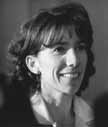 |
| Schmelzer |
When Senator Jim Jeffords of Vermont left the Republican party last year, the
job of Ranit Schmelzer '86 switched from "minor" to "major."
Schmelzer's boss-South Dakota Democrat Tom Daschle-became the Senate majority
leader when Jeffords left the GOP.
"It was truly a fascinating time to be there," says Schmelzer, who
is communications director for Daschle. "At the very last moment, the Republicans
really tried hard to convince him not to do it. It wasn't until that morning
that we knew 100 percent for sure that he was switching to an Independent and
would vote with the Democrats."
Long interested in politics, Schmelzer majored in political science at Rochester.
After graduation, she left for Washington, D.C., to volunteer for the campaign
of Senator Barbara Mikulski, a Maryland Democrat. Moving into a press secretary
position was unexpected, but she took to it quickly, and the job led to her
position on Daschle's staff. Nine months after signing on with him, Daschle
ran for what was then the majority (but became the minority) leadership of the
Senate and won by one vote, earning him the nickname "Landslide Daschle."
"That made his job and my job much more interesting," Schmelzer says.
"Some people think you get bigger offices and salaries as majority leader,
but you really don't. You just have to do more with what you already had."
The September 11 attacks changed much of the political climate in Washington,
Schmelzer says. Members of a very partisan Congress began working closely with
each other and with the president.
"Senator Daschle always believed the country should come together in difficult
times. He says partisanship should stop at the water's edge, and this is the
most extreme example of that."
Daschle's name has been mentioned as a possible contender for the presidency
in 2004, but Schmelzer says his staff is solely focused on keeping the Democratic
majority in 2002. She points out that in the positions up for reelection this
year, Democrats may have the more difficult challenges.
All these issues make her job very busy, and as the terrorist attacks took
place and anthrax was found in a letter delivered to Daschle's office, Schmelzer
was home on maternity leave with her new son. But she says she stays busy on
conference calls and still has time to volunteer tutoring children with the
D.C.-area charity Horton's Kids.
"I'm fortunate to get to be involved in all the very big news stories
that involve politicians," she says. "There have been some tremendous
events since I've been working for Senator Daschle. It's an exciting place to
be."
A CORNERBACK'S COMEBACK
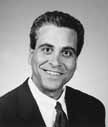 |
| Sebastianelli |
Almost a year to the day after bursting his fifth cervical vertebra in his
neck and bruising his spinal cord, Penn State cornerback Adam Taliaferro led
the Nittany Lions onto the field in the 2001 season opener, and he did it running.
"I couldn't control my tears," says Wayne Sebastianelli '79,
'83M (MD), '88M (Res), director of athletic medicine and assistant professor
of orthopedic surgery and rehabilitation at Penn State. "It was one of
the best feelings in the world to see a kid who was unable to do a thing for
himself turn into someone who's going to be very, very functional. I just had
a small role, but to be able to contribute to his overall well-being and recovery
was really rewarding."
From the beginning, that full recovery was in doubt. When Taliaferro made an
awkward tackle on September 23, 2000, landing on the crown of his head, Sebastianelli
said to the team trainer, "I don't like this one at all."
"Everyone's worst nightmare was happening," he says. "It took
me a while just to get over the expression on (Taliaferro's) face and the fear
in his eyes."
Immediately, Sebastianelli and the other Penn State doctors were at Taliaferro's
side, immobilizing him and removing his helmet and shoulder pads, a task that
Sebastianelli says is extremely difficult when a player has a spinal injury.
Sebastianelli supervises and directs the 29 NCAA Division I sports teams at
Penn State, providing primary care, orthopedic surgery, athletic training, physical
therapy, and drug testing. His own football injuries, both in high school and
while playing middle guard at Rochester, prompted him to choose sports medicine
as his specialty. He was close to choosing a Division I school to play football,
but Rochester's medical program won him over.
"It's amazing how a 17-year-old kid can make a decision that ends up being
the best decision he ever made. Rochester was good to me."
Sebastianelli's duties allowed him to be closely involved with Taliaferro's
recovery. The cornerback spent the next year undergoing rigorous physical therapy,
and Sebastianelli flew to Philadelphia almost every week to oversee the cornerback's
treatment
"He's an emotionally solid kid who, if you tell him to focus on something,
he's going to get it done," he says. "We were devastated when we looked
at the original X-rays and MRI and just thought that there was no way."
"This was a once-in-a-lifetime recovery."
DO YOU TAKE THIS BREADWINNER?
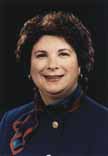 |
| Minetor |
Randi Bassow Minetor '88 (MA) realized four years ago that she was in
a difficult place in her marriage. She was making more money than her husband,
Nick Minetor, and she was doing all the housework and cooking. Things were awkward,
until she pinpointed the problem.
"I couldn't figure out how I got myself into this situation," she
says. "I went looking for a book, and there was no book. I'm a writer;
so I decided to write it."
Minetor's book, Breadwinner Wives and the Men They Marry, is the first book
geared toward "breadwinner wives"-women who make more money than their
husbands. In stores in December, the self-help book is for both men and women.
"When you think of a breadwinner, you think of the '50s and '60s when
just the men worked and had command of the household," she says. "Breadwinner
wives tend not to take the power in a relationship for their own. Instead of
power, they seek partnership with their husbands."
After receiving her master's in film theory, Minetor joined the Rochester advertising
agency Saphar & Associates, where she was, at times, responsible for video
and broadcast commercials. About three years ago, she started her own virtual
ad agency, Minetor & Co., which focuses on business-to-business advertising
and public relations.
In research for the book, Minetor found that 29 percent of all married women
make more money than their husbands. Of those, 37 percent make less than $25,000
a year. "We're talking about regular people here," she says.
Contrary to the common stereotype, most husbands of breadwinner wives report
being perfectly content, Minetor says. They have more time to spend with their
children or the opportunity to pursue a career that interests them.
"If a man is there voluntarily, he's generally happy," Minetor says.
"If this is because of a layoff, disability, or just because the wife is
making more and that bugs the husband, then they're not happy. That's where
you get wives who do all the work around the house while husbands do nothing
and the insidious things people to do one another because they're not talking
about what's really wrong."
Although her husband makes a good living as well, she says problems existed
until they talked about the situation.
"We now do have one of those good marriages," Minetor says. "The
situation changed enormously, mostly because of our own outlook about it. To
hear what so many people have to say, it reinforces that Nick and I are on the
right track."
EASTMAN ALUM REVIVES JOHN BROWN'S BODY
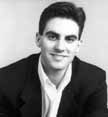 |
| Puts |
Turning an almost 400-page ballad poem into a 14-minute work wasn't easy, but
Kevin Puts '94E, '99E (DMA) says the challenge was half the fun. His
version of the Civil War epic John Brown's Body for narrator and orchestra had
its premiere July 4, 2001.
Randy Johnson, a board member of the Pacific Symphony Orchestra in Los Angeles,
commissioned Puts to write the piece and acted as narrator for the debut. They
hope the work gets played at other times as well, giving it a life beyond its
premiere.
"It had a very good response. I was really pleased," Puts says. "They
had very limited rehearsal time, but it all came together, and the audience
really responded."
Creating an orchestra piece with narration is a challenge, Puts says. The original
epic by Stephen Vincent Benet was written in 1928 and won the Pulitzer Prize
for poetry in 1929. Very little of a poem as long and dated as John Brown's
Body can be recited, and the narrator needs precise cues. To match the mood
of the poem, Puts treated the piece like a film score.
"I tried to evoke each image as clearly and powerfully as I could,"
he says.
Puts, a University of Texas assistant professor of composition, spent the last
year in Rome writing music as a winner of the Prix de Rome. He was encouraged
at the Eastman School of Music to spend time as both a composer and pianist,
which he says helped him develop a diverse career that includes performing,
conducting, and composing music.
"They emphasized that being a well-rounded musician was crucial, and now
I have that attitude toward my career," Puts says. "The composition
department was very open-minded about styles, and that helped me feel that I
can express myself in various ways."
Approaching an orchestra composition from a literary point of view appealed
to Puts, who says he would have been a writer if he weren't a musician. Other
recent efforts include composing a patriotic symphony piece for the Boston Pops
and even dabbling in writing music for a Korean pop star.
And after John Brown's Body, he's excited about a piece he composed based on
Beethoven's seventh symphony for the Phoenix Symphony's Beethoven Festival and
a work in response to the terrorist attacks of September 11 for the American
Composers Orchestra that will premiere at Carnegie Hall in April.
"Everything has its own set of challenges," he says. "I really
welcome the challenge."
RILEY '80 FORGES LIFE IN FRONT OF CAMERA
Slasher movies, mainstream releases, Broadway plays, one-woman shows, infomercials,
talk shows-Francine Forbes '80, now known as Forbes Riley, sums up the
diversity of her career in two words: "attention deficiency."
"If I could have been the next Julia Roberts and been a big movie star,
I would have loved that," Riley says. "But instead of getting a huge
shot like a few people do, I got a lot of little shots."
Most recently, Riley appeared in the film Megiddo: Omega Code 2, playing
in about 400 theaters nationwide. She also hosted Essentials, a talk
show for women on the Learning Channel, in addition to her duties selling fitness
products on the home shopping channel QVC and starring in a play in California.
When she came to Rochester, Riley was planning to become a lawyer. The double
major in political science and film had been acting and dancing for much of
her life, and she starred in and directed several plays at the University. This
led to her first acting role after college: the lead in Splatter University.
"It was one of those dreadful horror, slasher movies, but I had the lead,"
she says. "My criteria was that I didn't care if people got killed, I just
didn't want to do nudity."
Riley took on a number of projects to get in front of an audience. She began
hosting stand-up comedy shows, a job that led to hosting ESPN's X Games.
Before moving to QVC, Riley was host of the fitness program Body By Jake.
"There's no one area I most excelled in, except for communication"
she says. "Everything I do involves communication and how it's able to
inspire people."
Her most recent project was the lead in the play Who's Hot, Who's Not,
shown at Laguna Playhouse in California. The role has been one of her favorites.
Riley says her QVC job allows her to work a limited number of days a year,
freeing up more time for acting in plays and expanding the number of her appearances.
"I've been really fortunate," she says. "I'm able to make my
living in front of the camera, doing what I love. It's my absolute passion."
TIME CITES ALUM'S HOUSEWORK
Cheryl Neel Mendelson '73 (PhD) received the "Home Economist"
designation in a special section of Time magazine's summer 2001 issue.
The magazine, which was recognizing nationwide innovators highlighted Mendelson
for her housekeeping book, Home Comforts.
In writing the book, Mendelson studied old-time housework manuals and consulted
experts from fire fighters to microbiologists. The final work was lauded as
legitimizing housework and touches on topics that include how to get out a stain,
how to properly sweep a floor, how to remove candle wax, and many others.
"It's housekeeping that turns your home into a vital place where you can
be more yourself than you can be anywhere else," Mendelson was quoted in
the article.
EASTMAN ALUMNI HONOR FENNELL
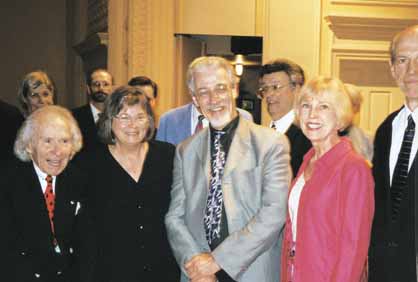 |
| Fennell (left) and Wind Ensemble alumni |
Frederick Fennell '37E, '39E (MS), '88E (HNR), a longtime conductor
of wind ensembles, conducted a special performance in Washington, D.C., on May
19, 2001, as part of the Library of Congress Concert Series. Many musicians
who were in the Eastman Wind Ensemble during Fennell's years as conductor flew
from various cities to join in the performance.
Among those returning were Phillip Kolker '63E, '67E (MM), principal
bassonist for the Baltimore Symphony; hornist Carl (Jeff) Bianchi '64E,
conductor of the American Youth Symphony; Ronald Barnett '60E, a member
of the percussion faculty at the University of Maryland School of Music; hornist
Robert Sheldon '60E, curator of the Musical Instruments Collections at
the Library of Congress; Thomas Miller '53E, '54E (MM), who plays the
euphonium and was one of the original members of the Wind Ensemble; Sandra
Flesher '60E, '65E (MM), principal oboist of the Oklahoma City Philharmonic;
Jerry Smith '63E (PhD), former director of Oklahoma School of Music and
clarinetist; Albert Merz '64E, percussionist with the National Symphony;
and trombonist Donald King '64E, '65E (MM), a member of the Kennedy Center
Opera House Orchestra.
Other ensemble members performing at the event included contrabassist Elizabeth
Twaddell Ferrell '56E, trombonist David Fetter '60E, oboist Keith
Kummer '51E, saxophonist Albert Regni '58E, and saxophonist Robert
Silberstein '53E.
The Washington Post wrote of the performance, "The legendary Frederick
Fennell . . . is at 87 so full of sap you wouldn't believe it. This is the man
who in the 1950s astonished the world . . . with his Mercury recordings by the
Eastman Symphonic Wind Ensemble. . . . That achievement set a standard for band
music that has never been equaled, except by Fennell himself."
To celebrate the 50th anniversary of the Wind Ensemble, an international conference
and concert was scheduled for February 6-9, 2002, at the Eastman School. Highlights
include world premieres of newly commissioned works, workshops, and presentations.
Fennell was scheduled to join his successor, A. Clyde Roller, and 36-year conductor
Donald Hunsberger.
LIGHTS, CAMERA, CINEMATOGRAPHY!
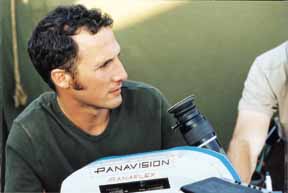 |
| Morgenthau |
As a freelance cinematographer, Kramer Morgenthau '89 can't always be
choosy about what films he works on. But if he had his choice, they would be
films that have a deeper social meaning.
"I always try to pick films that make a difference or say something meaningful
about the world or about social issues," Morgenthau says.
A recent film that intrigued him was Green Dragon, which premiered this
year at the prestigious Sundance Film Festival. Directed by Timothy Bui, it
is the story of Vietnamese citizens who took refuge in the United States during
the Vietnam War and were housed at refugee camps in various parts of the United
States.
As a cinematographer, Morgenthau is responsible for all the visual aspects
of a film, including the type of lighting and placement of actors and their
environment. For Green Dragon, the challenge was making something as
simple as a marine base in the desert visually expressive, Morgenthau says.
"Just being recognized by the independent film world is amazing,"
he says. "This is a very dry market for independent films, so when you
get picked up, it's a big achievement."
Morgenthau had no plans to work on films until he arrived at Rochester and
began making independent films for fun. He took classes in the history and politics
of film and fell in love with movie making.
After leaving Rochester, he worked as a production assistant in Manhattan and
moved his way up through lighting into cinematography. He has since worked on
commercials and other films and documentaries.
One documentary, titled Small Wonders, was nominated for an Academy
Award. Of his 15 feature films, his favorite is 1998's Big Brass Ring,
based on an unproduced script by Orson Welles.
A new film, The Man from Elysian Fields, premiered in September at the
Toronto Film Festival. Directed by George Hickenlooper, the film is expected
to be seen on a wider scale in the near future.
"I've been really lucky to work on a lot of different films," he
says. "These are some really exciting projects."
Maintained by University Public Relations
Please send your comments and suggestions to:
Rochester Review.
[an error occurred while processing this directive]

![[NEWS AND FACTS BANNER]](/URClipArt/misc/newsfacts.jpg)






